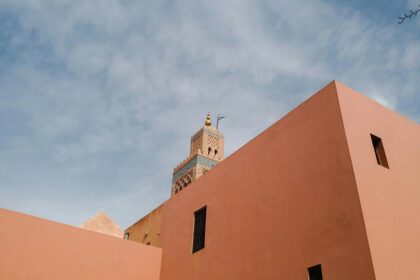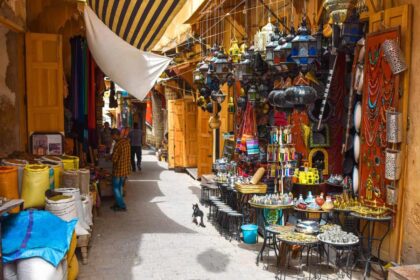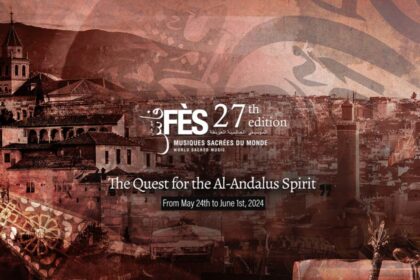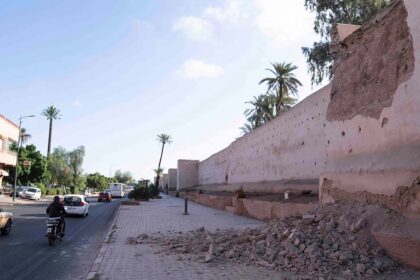In a rare and formidable seismic event, Morocco was shaken by a potent earthquake, propelling inhabitants from their slumber into the streets and precipitating the collapse of edifices in mountainous hamlets and venerable cities, ill-equipped to endure such relentless vigor. The aftermath proved devastating, with a death toll exceeding 2,000, a number expected to ascend as intrepid rescuers toiled to access remote regions bearing the brunt of the catastrophe, their unfortunate inhabitants interred beneath the debris.
This magnitude-6.8 temblor, the most robust to rock the North African terrain in a span of 120 years, prompted a frenzied exodus from residences as the populace grappled with incredulity and dread late on that fateful Friday eve. As recounted by an eyewitness, crockery and wall adornments cascaded, prostrating individuals in their wake. In the harsh daylight, the full scope of devastation materialized.
Structures of stone and masonry, ill-equipped for seismic tumult, succumbed, cloaking entire communities in ruins and leaving their denizens to navigate treacherous pathways strewn with debris. In the destitute highland enclave of Moulay Brahim, customarily graced by celebratory tents, clay and brick abodes lay largely uninhabitable. Heart-wrenching sobs emanated from fathers recounting the loss of their offspring over telephone lines. Blanketed cadavers found repose in the vicinity of a medical facility adjacent to a mosque, as medical practitioners extracted splinters from wounded feet and tended to surface injuries.
In the words of Hamza Lamghani, who mourned the loss of five dear companions, “There’s nothing to do but pray.”
Marrakech, renowned for its historic grandeur, bore the brunt of the cataclysm, its denizens wary of returning to potentially unstable structures. Many sought solace under blankets as they endeavored to slumber beneath the open sky.
The venerable Koutoubia Mosque, a 12th-century architectural marvel, sustained damage of uncertain magnitude. Its 69-meter minaret, colloquially known as the “roof of Marrakech,” potentially bore scars of the catastrophe. Videos circulating amongst Moroccans depicted harm inflicted upon segments of the iconic red walls encircling the ancient city, a UNESCO World Heritage site.
According to reports from Morocco’s Interior Ministry, the death toll climbed to at least 1,037, predominantly within Marrakech and the five surrounding provinces near the quake’s epicenter. Additionally, 1,204 individuals sustained injuries, with 721 in critical condition, as detailed by the ministry.
Bill McGuire, an esteemed professor specializing in geophysical and climate hazards, elucidated the perilous repercussions of infrequent seismic events in regions unaccustomed to such trials. He noted, “The problem is that where destructive earthquakes are rare, buildings are simply not constructed robustly enough to cope with strong ground shaking, so many collapse, resulting in high casualties.” The prognosis suggested that the eventual death toll would likely surge into the thousands, exacerbated by potential aftershocks impeding rescue efforts.
King Mohammed VI of Morocco, recognizing the monumental scale of the disaster, deployed the armed forces alongside specialized search and rescue teams, along with a field hospital. Nevertheless, formal requests for external assistance had not been issued by the Moroccan government, a prerequisite for the deployment of foreign rescue contingents.
Ayoub Toudite, recounting the calamity that befell Moulay Brahim, described the terrifying experience: “We felt a huge shake like it was doomsday.” In a mere 10 seconds, their world was irrevocably altered.
Rescuers, wielding hammers and axes, fervently endeavored to liberate an individual ensnared beneath the remnants of a two-story edifice. Those capable of squeezing into the confined space offered sustenance in the form of water.
In a poignant scene, scores of men congregated in the town, escorting a procession of shrouded bodies from the health center to the central square. Kneeling on rugs, they engaged in a funeral ritual, bidding farewell to the departed before their final resting place.
The epicenter of the tremor, with a preliminary magnitude of 6.8, resided near the town of Ighil in Al Haouz Province, approximately 70 kilometers south of Marrakech. Al Haouz, characterized by its picturesque villages nestled within the High Atlas Mountains, bore the brunt of the quake’s force.
Despite the mobilization of Moroccan military assets, including aircraft, helicopters, and drones, as well as the concerted efforts of emergency services, access to the rugged mountainous terrain surrounding the epicenter proved arduous. Roads were obstructed by vehicular congestion and fallen rocks, impeding the progress of relief convoys laden with blankets, camp cots, and illumination equipment.
World leaders extended offers of aid and condolences, with Europe, the Middle East, and the Group of 20 summit nations expressing their solidarity. The president of Turkey, having endured a catastrophic earthquake earlier that year, was among the countries offering assistance. France and Germany, each harboring sizable Moroccan-origin populations, also pledged their support, while the leaders of Ukraine and Russia conveyed their sympathies to the Moroccan people.
In an extraordinary gesture of goodwill, Algeria, Morocco’s neighboring rival, offered to open its airspace to facilitate humanitarian aid and medical evacuation flights, despite ongoing diplomatic tensions between the two nations. The U.S. Geological Survey, which monitored the event, initially reported a magnitude of 6.8 for the earthquake, accompanied by a subsequent aftershock measuring 4.9. The shallowness of the African-Eurasian tectonic plate collision rendered the quake particularly hazardous.
In a region where seismic events are infrequent, Lahcen Mhanni, Head of the Seismic Monitoring and Warning Department at the National Institute of Geophysics, affirmed that this earthquake constituted the most formidable on record. While previous catastrophes had prompted alterations to construction regulations, many structures, particularly rural dwellings, remained ill-prepared to withstand such formidable tremors.
The memory of the 1960 earthquake near Agadir, measuring 5.8 in magnitude and resulting in significant loss of life, lingered as a stark reminder of the perils inherent to the region. In 2004, a 6.4 magnitude earthquake near the coastal city of Al Hoceima claimed over 600 lives.
The seismic upheaval of that fateful Friday reverberated as far afield as Portugal and Algeria, underscoring the profound impact of this cataclysmic event.













